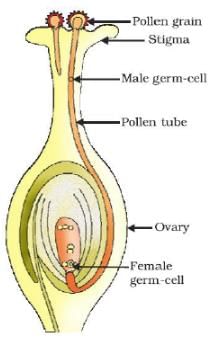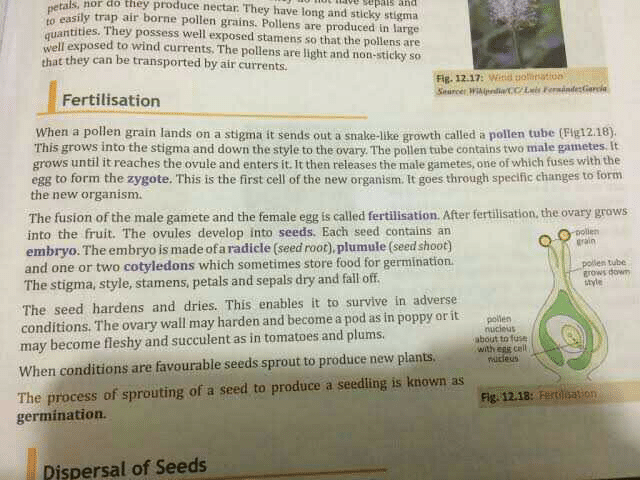Class 7 Exam > Class 7 Questions > how does the process of fertilisation take pl...
Start Learning for Free
how does the process of fertilisation take place in flowers?
Verified Answer
how does the process of fertilisation take place in flowers?
When pollen lands on stigma, it germinates and gives rise to a pollen tube that passes through the style and reaches the ovary of a pistil. When the pollen tube reaches an ovule, it releases the male gametes. A male gamete fuses with a female gamete in the ovule. This process is known as fertilisation. The cell which is formed after the fusion of a male and a female gamete is known as zygote. This zygote divides several times in order to form the embryo present inside the seed.

 This question is part of UPSC exam. View all Class 7 courses
This question is part of UPSC exam. View all Class 7 courses
Most Upvoted Answer
how does the process of fertilisation take place in flowers?

Community Answer
how does the process of fertilisation take place in flowers?
Fertilization in Flowers
Fertilization is a crucial process in the reproductive cycle of flowering plants. It involves the fusion of male and female gametes to form a zygote, which eventually develops into an embryo. Let's explore the detailed process of fertilization in flowers.
1. Pollination:
Pollination is the first step in the process of fertilization. It can occur through various mechanisms, including self-pollination (transfer of pollen within the same flower) or cross-pollination (transfer of pollen between different flowers). Pollen grains, containing the male gametes, are produced in the anthers of the flower. They are released and then transported to the stigma, which is part of the female reproductive structure.
2. Germination of Pollen:
Once the pollen grains land on the stigma, they must germinate to initiate fertilization. This process involves the growth of a pollen tube from the pollen grain. The pollen tube grows through the style, a long tube-like structure that connects the stigma to the ovary.
3. Double Fertilization:
Double fertilization is a unique characteristic of flowering plants. It involves the fusion of two gametes from the male pollen tube with two different female gametes. The two female gametes are located within the ovule, which is present in the ovary.
- Fertilization of the Egg Cell: One of the male gametes fuses with the egg cell, resulting in the formation of a zygote. The zygote is the beginning of the new plant embryo.
- Fertilization of the Central Cell: The other male gamete fuses with the central cell, which contains two polar nuclei. This fusion forms a triploid cell, which develops into the endosperm. The endosperm serves as a nutrient source for the developing embryo.
4. Embryo Development:
After fertilization, the zygote undergoes cell division and differentiation, leading to the development of an embryo. It develops within the ovule, which later becomes the seed. The endosperm also undergoes cell division and forms a nutritive tissue that supports the growing embryo.
5. Seed Formation:
As the embryo develops, other structures of the flower, such as the petals and sepals, wither and fall off. The ovary matures and becomes a fruit, enclosing the developing seeds. The seeds contain the embryo and are dispersed by various means, such as wind, water, or animals.
In conclusion, the process of fertilization in flowers involves pollination, germination of pollen, double fertilization, embryo development, and seed formation. This intricate process ensures the successful reproduction of flowering plants and the production of new generations.
Fertilization is a crucial process in the reproductive cycle of flowering plants. It involves the fusion of male and female gametes to form a zygote, which eventually develops into an embryo. Let's explore the detailed process of fertilization in flowers.
1. Pollination:
Pollination is the first step in the process of fertilization. It can occur through various mechanisms, including self-pollination (transfer of pollen within the same flower) or cross-pollination (transfer of pollen between different flowers). Pollen grains, containing the male gametes, are produced in the anthers of the flower. They are released and then transported to the stigma, which is part of the female reproductive structure.
2. Germination of Pollen:
Once the pollen grains land on the stigma, they must germinate to initiate fertilization. This process involves the growth of a pollen tube from the pollen grain. The pollen tube grows through the style, a long tube-like structure that connects the stigma to the ovary.
3. Double Fertilization:
Double fertilization is a unique characteristic of flowering plants. It involves the fusion of two gametes from the male pollen tube with two different female gametes. The two female gametes are located within the ovule, which is present in the ovary.
- Fertilization of the Egg Cell: One of the male gametes fuses with the egg cell, resulting in the formation of a zygote. The zygote is the beginning of the new plant embryo.
- Fertilization of the Central Cell: The other male gamete fuses with the central cell, which contains two polar nuclei. This fusion forms a triploid cell, which develops into the endosperm. The endosperm serves as a nutrient source for the developing embryo.
4. Embryo Development:
After fertilization, the zygote undergoes cell division and differentiation, leading to the development of an embryo. It develops within the ovule, which later becomes the seed. The endosperm also undergoes cell division and forms a nutritive tissue that supports the growing embryo.
5. Seed Formation:
As the embryo develops, other structures of the flower, such as the petals and sepals, wither and fall off. The ovary matures and becomes a fruit, enclosing the developing seeds. The seeds contain the embryo and are dispersed by various means, such as wind, water, or animals.
In conclusion, the process of fertilization in flowers involves pollination, germination of pollen, double fertilization, embryo development, and seed formation. This intricate process ensures the successful reproduction of flowering plants and the production of new generations.

|
Explore Courses for Class 7 exam
|

|
Question Description
how does the process of fertilisation take place in flowers? for Class 7 2025 is part of Class 7 preparation. The Question and answers have been prepared according to the Class 7 exam syllabus. Information about how does the process of fertilisation take place in flowers? covers all topics & solutions for Class 7 2025 Exam. Find important definitions, questions, meanings, examples, exercises and tests below for how does the process of fertilisation take place in flowers?.
how does the process of fertilisation take place in flowers? for Class 7 2025 is part of Class 7 preparation. The Question and answers have been prepared according to the Class 7 exam syllabus. Information about how does the process of fertilisation take place in flowers? covers all topics & solutions for Class 7 2025 Exam. Find important definitions, questions, meanings, examples, exercises and tests below for how does the process of fertilisation take place in flowers?.
Solutions for how does the process of fertilisation take place in flowers? in English & in Hindi are available as part of our courses for Class 7.
Download more important topics, notes, lectures and mock test series for Class 7 Exam by signing up for free.
Here you can find the meaning of how does the process of fertilisation take place in flowers? defined & explained in the simplest way possible. Besides giving the explanation of
how does the process of fertilisation take place in flowers?, a detailed solution for how does the process of fertilisation take place in flowers? has been provided alongside types of how does the process of fertilisation take place in flowers? theory, EduRev gives you an
ample number of questions to practice how does the process of fertilisation take place in flowers? tests, examples and also practice Class 7 tests.

|
Explore Courses for Class 7 exam
|

|
Signup for Free!
Signup to see your scores go up within 7 days! Learn & Practice with 1000+ FREE Notes, Videos & Tests.























